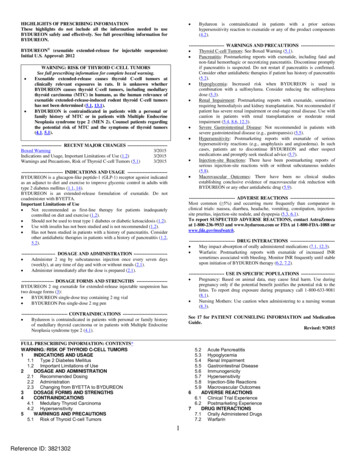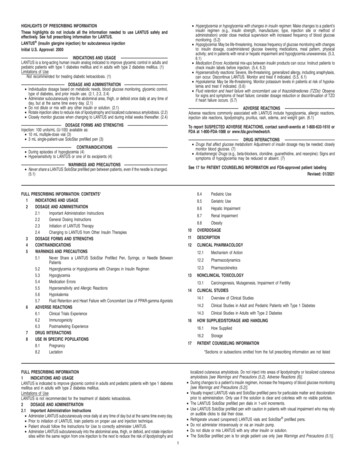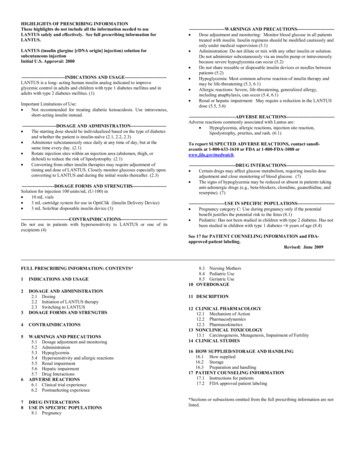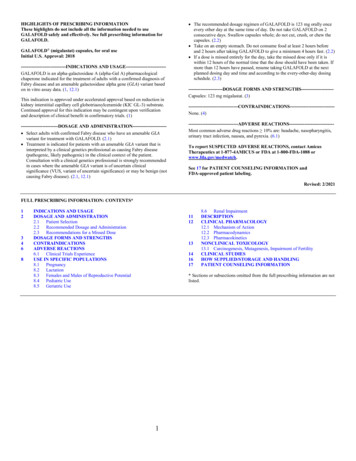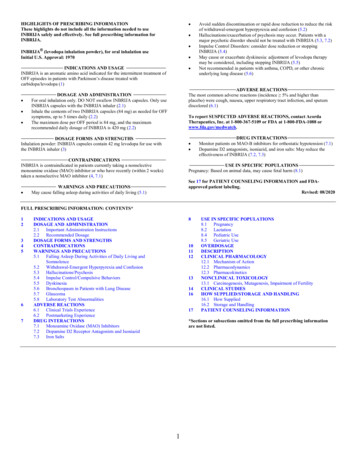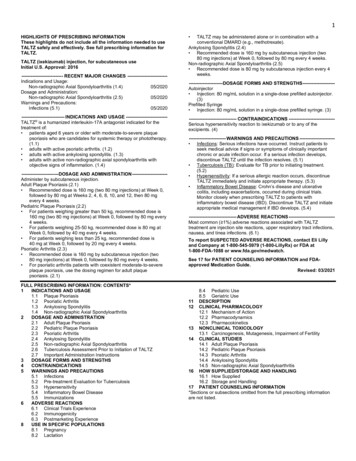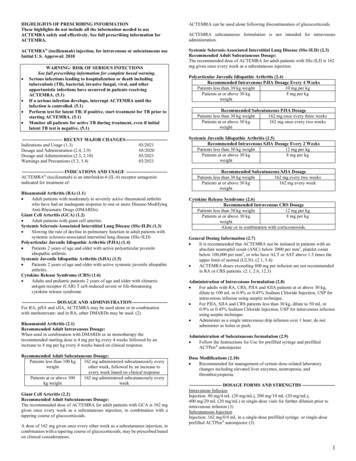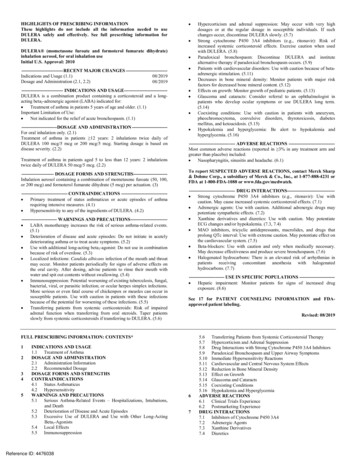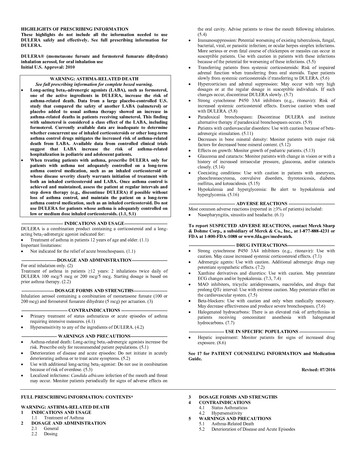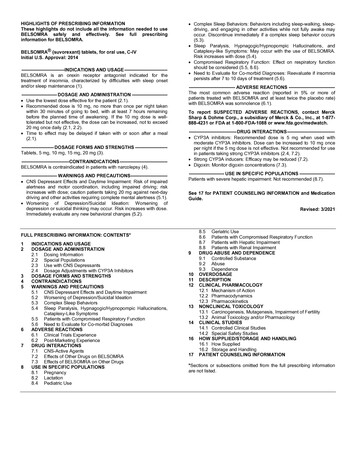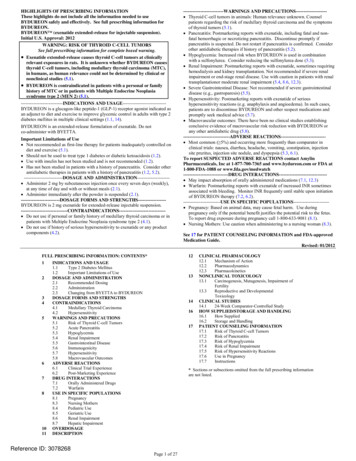
Transcription
HIGHLIGHTS OF PRESCRIBING INFORMATIONThese highlights do not include all the information needed to useBYDUREON safely and effectively. See full prescribing information forBYDUREON.BYDUREON (exenatide extended-release for injectable suspension).Initial U.S. Approval: 2012 WARNING: RISK OF THYROID C-CELL TUMORSSee full prescribing information for complete boxed warning.Exenatide extended-release causes thyroid C-cell tumors at clinicallyrelevant exposures in rats. It is unknown whether BYDUREON causesthyroid C-cell tumors, including medullary thyroid carcinoma (MTC),in humans, as human relevance could not be determined by clinical ornonclinical studies (5.1).BYDUREON is contraindicated in patients with a personal or familyhistory of MTC or in patients with Multiple Endocrine Neoplasiasyndrome type 2 (MEN 2) (5.1).---------------------------INDICATIONS AND USAGE---------------------------BYDUREON is a glucagon-like peptide-1 (GLP-1) receptor agonist indicated asan adjunct to diet and exercise to improve glycemic control in adults with type 2diabetes mellitus in multiple clinical settings (1.1, 14).BYDUREON is an extended-release formulation of exenatide. Do notco-administer with BYETTA.Important Limitations of Use Not recommended as first-line therapy for patients inadequately controlled ondiet and exercise (5.1). Should not be used to treat type 1 diabetes or diabetic ketoacidosis (1.2). Use with insulin has not been studied and is not recommended (1.2). Has not been studied in patients with a history of pancreatitis. Consider otherantidiabetic therapies in patients with a history of pancreatitis (1.2, 5.2).-------------------------DOSAGE AND ADMINISTRATION-------------------- Administer 2 mg by subcutaneous injection once every seven days (weekly),at any time of day and with or without meals (2.1). Administer immediately after the powder is suspended (2.1).-------------------------DOSAGE FORMS AND STRENGTHS-----------------BYDUREON is 2 mg exenatide for extended-release injectable ICATIONS----------------------------- Do not use if personal or family history of medullary thyroid carcinoma or inpatients with Multiple Endocrine Neoplasia syndrome type 2 (4.1). Do not use if history of serious hypersensitivity to exenatide or any productcomponents (4.2).FULL PRESCRIBING INFORMATION: CONTENTS*123456781011See 17 for PATIENT COUNSELING INFORMATION and FDA-approvedMedication Guide.Revised: 01/201212INDICATIONS AND USAGE1.1Type 2 Diabetes Mellitus1.2Important Limitations of UseDOSAGE AND ADMINISTRATION2.1Recommended Dosing2.2Administration2.3Changing from BYETTA to BYDUREONDOSAGE FORMS AND STRENGTHSCONTRAINDICATIONS4.1Medullary Thyroid Carcinoma4.2HypersensitivityWARNINGS AND PRECAUTIONS5.1Risk of Thyroid C-cell Tumors5.2Acute Pancreatitis5.3Hypoglycemia5.4Renal Impairment5.5Gastrointestinal ovascular OutcomesADVERSE REACTIONS6.1Clinical Trial Experience6.2Post-Marketing ExperienceDRUG INTERACTIONS7.1Orally Administered Drugs7.2WarfarinUSE IN SPECIFIC POPULATIONS8.1Pregnancy8.3Nursing Mothers8.4Pediatric Use8.5Geriatric Use8.6Renal Impairment8.7Hepatic ImpairmentOVERDOSAGEDESCRIPTIONReference ID: 3078268--------------------------WARNINGS AND PRECAUTIONS------------------- Thyroid C-cell tumors in animals: Human relevance unknown. Counselpatients regarding the risk of medullary thyroid carcinoma and the symptomsof thyroid tumors (5.1). Pancreatitis: Postmarketing reports with exenatide, including fatal and nonfatal hemorrhagic or necrotizing pancreatitis. Discontinue promptly ifpancreatitis is suspected. Do not restart if pancreatitis is confirmed. Considerother antidiabetic therapies if history of pancreatitis (5.2). Hypoglycemia: Increased risk when BYDUREON is used in combinationwith a sulfonylurea. Consider reducing the sulfonylurea dose (5.3). Renal Impairment: Postmarketing reports with exenatide, sometimes requiringhemodialysis and kidney transplantation. Not recommended if severe renalimpairment or end-stage renal disease. Use with caution in patients with renaltransplantationor moderate renal impairment (5.4, 8.6, 12.3). Severe Gastrointestinal Disease: Not recommended if severe gastrointestinaldisease (e.g., gastroparesis) (5.5). Hypersensitivity: Postmarketing reports with exenatide of serioushypersensitivity reactions (e.g. anaphylaxis and angioedema). In such cases,patients are to discontinue BYDUREON and other suspect medications andpromptly seek medical advice (5.7). Macrovascular outcomes: There have been no clinical studies establishingconclusive evidence of macrovascular risk reduction with BYDUREON orany other antidiabetic drug (5.8).------------------------------ADVERSE REACTIONS---------------------------- Most common ( 5%) and occurring more frequently than comparator inclinical trials: nausea, diarrhea, headache, vomiting, constipation, injectionsite pruritus, injection site nodule, and dyspepsia (5.3, 6.1).To report SUSPECTED ADVERSE REACTIONS contact AmylinPharmaceuticals, Inc at 1-877-700-7365 and www.bydureon.com or FDA at1-800-FDA-1088 or RUG INTERACTIONS------------------------------ May impact absorption of orally administered medications (7.1, 12.3) Warfarin: Postmarketing reports with exenatide of increased INR sometimesassociated with bleeding. Monitor INR frequently until stable upon initiationof BYDUREON therapy (7.2, 6.2).------------------------USE IN SPECIFIC POPULATIONS---------------------- Pregnancy: Based on animal data, may cause fetal harm. Use duringpregnancy only if the potential benefit justifies the potential risk to the fetus.To report drug exposure during pregnancy call 1-800-633-9081 (8.1). Nursing Mothers: Use caution when administering to a nursing woman (8.3).13141617CLINICAL PHARMACOLOGY12.1Mechanism of LINICAL TOXICOLOGY13.1Carcinogenesis, Mutagenesis, Impairment ofFertility13.3Reproductive and DevelopmentalToxicologyCLINICAL STUDIES14.124-Week Comparator-Controlled StudyHOW SUPPLIED/STORAGE AND HANDLING16.1How Supplied16.2Storage and HandlingPATIENT COUNSELING INFORMATION17.1Risk of Thyroid C-cell Tumors17.2Risk of Pancreatitis17.3Risk of Hypoglycemia17.4Risk of Renal Impairment17.5Risk of Hypersensitivity Reactions17.6Use in Pregnancy17.7Instructions* Sections or subsections omitted from the full prescribing informationare not listed.Page 1 of 27
FULL PRESCRIBING INFORMATIONWARNING: RISK OF THYROID C-CELL TUMORSExenatide extended-release causes an increased incidence in thyroid C-cell tumors at clinicallyrelevant exposures in rats compared to controls. It is unknown whether BYDUREON causesthyroid C-cell tumors, including medullary thyroid carcinoma (MTC), in humans, as humanrelevance could not be determined by clinical or nonclinical studies. BYDUREON iscontraindicated in patients with a personal or family history of MTC and in patients withMultiple Endocrine Neoplasia syndrome type 2 (MEN 2). Routine serum calcitonin or thyroidultrasound monitoring is of uncertain value in patients treated with BYDUREON. Patientsshould be counseled regarding the risk and symptoms of thyroid tumors [see Contraindications(4.1), Warnings and Precautions (5.1) and Nonclinical Toxicology (13.1)].1INDICATIONS AND USAGEBYDUREON is an extended-release formulation of exenatide, administered as an injection onceevery seven days (weekly).1.1Type 2 Diabetes MellitusBYDUREON is indicated as an adjunct to diet and exercise to improve glycemic control inadults with type 2 diabetes mellitus in multiple clinical settings [see Clinical Studies (14)].1.2Important Limitations of UseBecause of the uncertain relevance of the rat thyroid C-cell tumor findings to humans, prescribeBYDUREON only to patients for whom the potential benefits are considered to outweigh thepotential risk.BYDUREON is not recommended as first-line therapy for patients who have inadequateglycemic control on diet and exercise.BYDUREON is not a substitute for insulin. BYDUREON should not be used in patients withtype 1 diabetes or for the treatment of diabetic ketoacidosis, as it would not be effective in thesesettings.The concurrent use of BYDUREON with insulin has not been studied and cannot berecommended.BYDUREON and BYETTA (exenatide) injection both contain the same active ingredient,exenatide, and therefore should not be used together.Based on postmarketing data, exenatide has been associated with acute pancreatitis, includingfatal and non-fatal hemorrhagic or necrotizing pancreatitis. BYDUREON has not been studied2 of 27Reference ID: 3078268
in patients with a history of pancreatitis. It is unknown whether patients with a history ofpancreatitis are at increased risk for pancreatitis while using BYDUREON. Other antidiabetictherapies should be considered in patients with a history of pancreatitis.22.1DOSAGE AND ADMINISTRATIONRecommended DosingBYDUREON (2 mg per dose) should be administered once every seven days (weekly). Thedose can be administered at any time of day, with or without meals.Missed DoseIf a dose is missed, it should be administered as soon as noticed, provided the next regularlyscheduled dose is due at least three days later. Thereafter, patients can resume their usual dosingschedule of once every seven days (weekly).If a dose is missed and the next regularly scheduled dose is due one or two days later, the patientshould not administer the missed dose and instead resume BYDUREON with the next regularlyscheduled dose.Changing Weekly Dosing ScheduleThe day of weekly administration can be changed if necessary as long as the last dose wasadministered 3 or more days before.2.2 AdministrationBYDUREON is intended for patient self-administration. BYDUREON is provided in asingle-dose tray containing: one vial of 2 mg exenatide, one vial connector, one prefilled diluentsyringe and two needles (one provided as a spare) [see How Supplied/Storage and Handling(16.1)]. Do not substitute needles or any other components in the tray.BYDUREON must be injected immediately after the powder is suspended in the diluent andtransferred to the syringe. BYDUREON is administered as a subcutaneous (SC) injection in theabdomen, thigh or upper arm region. Advise patients to use a different injection site each weekwhen injecting in the same region. BYDUREON must not be administered intravenously orintramuscularly.See the BYDUREON Instructions for Use for complete administration instructions withillustrations. The instructions can also be found at www.bydureon.com.2.3Changing from BYETTA to BYDUREONPrior treatment with BYETTA is not required when initiating BYDUREON therapy. If thedecision is made to start BYDUREON in an appropriate patient already taking BYETTA,3 of 27Reference ID: 3078268
BYETTA should be discontinued. Patients changing from BYETTA to BYDUREON mayexperience transient (approximately two weeks) elevations in blood glucose concentrations.3DOSAGE FORMS AND STRENGTHSBYDUREON is 2 mg exenatide extended-release for injectable suspension for subcutaneousadministration once every seven days (weekly).44.1CONTRAINDICATIONSMedullary Thyroid CarcinomaBYDUREON is contraindicated in patients with a personal or family history of medullarythyroid carcinoma (MTC) or in patients with Multiple Endocrine Neoplasia syndrome type 2(MEN 2).4.2HypersensitivityBYDUREON is contraindicated in patients with a prior serious hypersensitivity reaction toexenatide or to any of the product components.5WARNINGS AND PRECAUTIONS5.1 Risk of Thyroid C-cell TumorsIn both genders of rats, exenatide extended-release caused a dose-related and treatment-durationdependent increase in the incidence of thyroid C-cell tumors (adenomas and/or carcinomas) atclinically relevant exposures compared to controls [see Nonclinical Toxicology (13.1)]. Astatistically significant increase in malignant thyroid C-cell carcinomas was observed in femalerats receiving exenatide extended-release at 25-times clinical exposure compared to controls andhigher incidences were noted in males above controls in all treated groups at 2-times clinicalexposure. The potential of exenatide extended-release to induce C-cell tumors in mice has notbeen evaluated. Other GLP-1 receptor agonists have also induced thyroid C-cell adenomas andcarcinomas in male and female mice and rats at clinically relevant exposures. It is unknownwhether BYDUREON will cause thyroid C-cell tumors, including medullary thyroid carcinoma(MTC), in humans, as the human relevance of exenatide extended-release-induced rodent thyroidC-cell tumors could not be determined by clinical or nonclinical studies. Serum calcitonin wasnot assessed in the clinical trials supporting the approval of BYDUREON [see Boxed Warning,Contraindications (4.1)].Serum calcitonin is a biological marker of MTC. Patients with MTC usually have calcitoninvalues 50 ng/L. Patients with thyroid nodules noted on physical examination or neck imagingshould be referred to an endocrinologist for further evaluation. Routine monitoring of serumcalcitonin or using thyroid ultrasound is of uncertain value for early detection of MTC inpatients treated with BYDUREON. Such monitoring may increase the risk of unnecessary4 of 27Reference ID: 3078268
procedures, due to the low specificity of serum calcitonin testing for MTC and a highbackground incidence of thyroid disease. If serum calcitonin is measured and found to beelevated, the patient should be referred to an endocrinologist for further evaluation [see PatientCounseling Information (17)].5.2Acute PancreatitisBased on postmarketing data, exenatide has been associated with acute pancreatitis,including fatal and non-fatal hemorrhagic or necrotizing pancreatitis. After initiation ofBYDUREON, observe patients carefully for signs and symptoms of pancreatitis (includingpersistent severe abdominal pain, sometimes radiating to the back, which may or may notbe accompanied by vomiting). If pancreatitis is suspected, BYDUREON should promptlybe discontinued and appropriate management should be initiated. If pancreatitis isconfirmed, BYDUREON should not be restarted. Consider antidiabetic therapies otherthan BYDUREON in patients with a history of pancreatitis.5.3HypoglycemiaThe risk of hypoglycemia is increased when exenatide is used in combination with asulfonylurea. Therefore, patients receiving BYDUREON and a sulfonylurea may require a lowerdose of the sulfonylurea to minimize the risk of hypoglycemia. It is also possible that the use ofBYDUREON with other glucose-independent insulin secretagogues (e.g. meglitinides) couldincrease the risk of hypoglycemia.For additional information on glucose-dependent effects see Mechanism of Action (12.1).5.4Renal ImpairmentBYDUREON should not be used in patients with severe renal impairment (creatinine clearance 30 mL/min) or end-stage renal disease and should be used with caution in patients with renaltransplantation [see Use in Specific Populations (8.6)]. In patients with end-stage renal diseasereceiving dialysis, single doses of BYETTA 5 mcg were not well tolerated due to gastrointestinalside effects. Because BYDUREON may induce nausea and vomiting with transienthypovolemia, treatment may worsen renal function. Use BYDUREON with caution in patientswith moderate renal impairment (creatinine clearance 30 to 50 mL/min) [see Use in SpecificPopulations (8.6) Clinical Pharmacology (12.3)]. BYDUREON has not been studied in patientswith end-stage renal disease or severe renal impairment.There have been postmarketing reports of altered renal function with exenatide, includingincreased serum creatinine, renal impairment, worsened chronic renal failure and acute renalfailure, sometimes requiring hemodialysis or kidney transplantation. Some of these eventsoccurred in patients receiving one or more pharmacologic agents known to affect renal functionor hydration status such as angiotensin converting enzyme inhibitors, nonsteroidal antiinflammatory drugs, or diuretics. Some events occurred in patients who had been experiencing5 of 27Reference ID: 3078268
nausea, vomiting, or diarrhea, with or without dehydration. Reversibility of altered renalfunction has been observed in many cases with supportive treatment and discontinuation ofpotentially causative agents, including exenatide. Exenatide has not been found to be directlynephrotoxic in preclinical or clinical studies.5.5Gastrointestinal DiseaseExenatide has not been studied in patients with severe gastrointestinal disease, includinggastroparesis. Because exenatide is commonly associated with gastrointestinal adverse reactions,including nausea, vomiting, and diarrhea, the use of BYDUREON is not recommended inpatients with severe gastrointestinal disease.5.6ImmunogenicityPatients may develop antibodies to exenatide following treatment with BYDUREON. Antiexenatide antibodies were measured in all BYDUREON-treated patients in the five comparatorcontrolled 24-30 week studies of BYDUREON. In 6% of BYDUREON-treated patients,antibody formation was associated with an attenuated glycemic response. If there is worseningglycemic control or failure to achieve targeted glycemic control, alternative antidiabetic therapyshould be considered [see Adverse Reactions (6.1)].5.7HypersensitivityThere have been postmarketing reports of serious hypersensitivity reactions (e.g. anaphylaxisand angioedema) in patients treated with exenatide. If a hypersensitivity reaction occurs, thepatient should discontinue BYDUREON and other suspect medications and promptly seekmedical advice [see Adverse Reactions (6.2)].5.8Macrovascular OutcomesThere have been no clinical studies establishing conclusive evidence of macrovascular riskreduction with BYDUREON or any other antidiabetic drug.66.1ADVERSE REACTIONSClinical Trial ExperienceBecause clinical trials are conducted under widely varying conditions, adverse reaction ratesobserved in the clinical trials of a drug cannot be directly compared to rates in the clinical trialsof another drug and may not reflect the rates observed in practice.The safety of BYDUREON was assessed in five comparator-controlled trials, in patients whoentered the studies not achieving adequate glycemic control on their current therapy. In adouble-blind 26 week trial, patients on diet and exercise were treated with BYDUREON 2 mgonce every seven days (weekly), sitagliptin 100 mg daily, pioglitazone 45 mg daily, ormetformin 2000 mg daily. In a double-blind 26 week trial, patients on metformin were treated6 of 27Reference ID: 3078268
with BYDUREON 2 mg once every seven days (weekly), sitagliptin 100 mg daily, orpioglitazone 45 mg daily. In an open-label 26 week trial, patients on metformin or metforminplus sulfonylurea were treated with BYDUREON 2 mg once every seven days (weekly) oroptimized insulin glargine. In two open-label 24 to 30 week studies, patients on diet andexercise or metformin, a sulfonylurea, a thiazolidinedione or combination of oral agents weretreated with BYDUREON 2 mg once every seven days (weekly) or BYETTA 10 mcg twicedaily.WithdrawalsThe incidence of withdrawal due to adverse events was 4.9% (N 45) for BYDUREON-treatedpatients, 4.9% (N 13) for BYETTA-treated patients and 2.0% (N 23) for other comparatortreated patients in the five comparator-controlled 24-30 week trials. The most common adversereactions leading to withdrawal for BYDUREON-treated patients were nausea 0.5% (N 5)versus 1.5% (N 4) for BYETTA and 0.3 % (N 3) for other comparators, injection site nodule0.5% (N 5) versus 0.0% for BYETTA and 0.0% for other comparators, diarrhea 0.3% (N 3)versus 0.4% (N 1) for BYETTA and 0.3% (N 3) for other comparators, injection site reaction0.2% (N 2) versus 0.0% for BYETTA and 0.0% for other comparators and headache 0.2%(N 2) versus 0.0% for BYETTA and 0.0% for other comparators.HypoglycemiaTable 1 summarizes the
BYDUREON is intended for patient self-administration. BYDUREON is provided in a single-dose tray containing: one vial of 2 mg exenatide, one vial connector, one prefilled diluent syringe and two needles (one provided as a spare) [see How Supplied/Storage and Handling (16.1)]. Do no
